
The Curtiss-Wright XF-87 Blackhawk was a prototype American all-weather jet fighter-interceptor, and the company's last aircraft project. Designed as a replacement for the World War II–era propeller-driven P-61 Black Widow night/interceptor aircraft, the XF-87 lost in government procurement competition to the Northrop F-89 Scorpion. The loss of the contract was fatal to the company; the Curtiss-Wright Corporation closed down its aviation division, selling its assets to North American Aviation.

The Curtiss-Wright XP-55 Ascender is a 1940s United States prototype fighter aircraft built by Curtiss-Wright. Along with the Vultee XP-54 and Northrop XP-56, it resulted from United States Army Air Corps proposal R-40C issued on 27 November 1939 for aircraft with improved performance, armament, and pilot visibility over existing fighters; it specifically allowed for unconventional aircraft designs. An unusual design for its time, it had a canard configuration with a rear-mounted engine, and two vertical tails at end of swept wings. Because of its pusher design, it was satirically referred to as the "Ass-ender". Like the XP-54, the Ascender was designed for the 1,800 hp Pratt & Whitney X-1800 24-Cylinder H-engine, but was redesigned after that engine project was canceled. It was also the first Curtiss fighter aircraft to use tricycle landing gear.

The Consolidated Vultee XP-81 is a development of the Consolidated Vultee Aircraft Corporation to build a single seat, long range escort fighter that combined use of both turbojet and turboprop engines. Although promising, the lack of suitable engines combined with the end of World War II doomed the project.

The Bell XFL Airabonita was an American experimental carrier-based interceptor aircraft developed for the United States Navy by Bell Aircraft Corporation of Buffalo, New York. It was similar to and a parallel development of the U.S. Army Air Corps’ land-based P-39 Airacobra, differing mainly in the use of a tailwheel undercarriage in place of the P-39's tricycle gear. Only one prototype was built.

The Curtiss XP-46 was a 1940s American prototype fighter aircraft. It was a development of the Curtiss-Wright Corporation in an effort to introduce the best features found in European fighter aircraft in 1939 into a fighter aircraft which could succeed the Curtiss P-40, then in production.

The Curtiss P-60 was a 1940s American single-engine single-seat, low-wing monoplane fighter aircraft developed by the Curtiss-Wright company as a successor to their P-40. It went through a lengthy series of prototype versions, eventually evolving into a design that bore little resemblance to the P-40. None of these versions reached production.

The Curtiss XF14C was an American naval fighter aircraft. It was developed by Curtiss-Wright in response to a request by the United States Navy in 1941 to produce a new shipboard high-performance fighter aircraft.

The McDonnell XP-67 "Bat" or "Moonbat" was a prototype for a twin-engine, long-range, single-seat interceptor aircraft for the United States Army Air Forces. Although the design was conceptually advanced, it was beset by numerous problems and never approached its anticipated level of performance. The project was canceled after the sole completed prototype was destroyed by an engine fire.

The Republic XP-72 was an American prototype fighter-interceptor developed by Republic Aircraft as a progression of the P-47 Thunderbolt design. The XP-72 was designed around the Pratt & Whitney R-4360 Wasp Major 28-cylinder air-cooled radial engine with a supercharger mounted behind the pilot and driven by an extension shaft from the engine. The armament consisted of six .50 caliber (12.7 mm) wing-mounted Browning AN/M2 machine guns and underwing racks for two 1,000 lb bombs; Alternative armament packages included two 37 mm M4 autocannons with four .50 caliber AN/M2s, or four M4 autocannons.
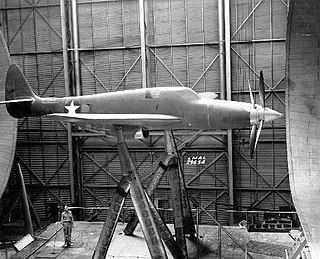
The Republic XP-69 was an American fighter aircraft proposed by Republic Aviation in 1941 in response to a requirement by the United States Army Air Corps for a high-speed fighter. Manufacturers were encouraged to consider unorthodox designs; although the design was ordered as a prototype it was canceled because of delays with the engine that was to power it.

The Vultee XP-54 Swoose Goose was a prototype fighter built by the Vultee Aircraft Company for the United States Army Air Forces (USAAF).

The Northrop XP-56 Black Bullet is a unique prototype fighter interceptor built by the Northrop Corporation. It was one of the most radical of the experimental aircraft built during World War II. Ultimately, it was unsuccessful and did not enter production.

The Curtiss XP-71 was a 1941 American proposal for an exceptionally large heavy fighter design. It was intended to serve as an extreme-range interceptor and escort fighter. While significant progress was made in the design phase, no prototypes were ever built, and the design was abandoned in 1943.

The Curtiss XP-42 was an experimental fighter built by Curtiss Aircraft in the late 1930s to research engine cooling and improving the performance of the Curtiss P-36 Hawk.
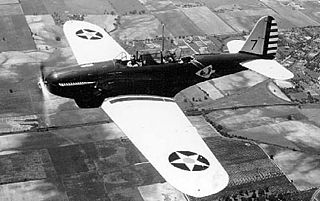
The Consolidated P-30 (PB-2) was a 1930s United States two-seat fighter aircraft. An attack version called the A-11 was also built, along with 2 Y1P-25 prototypes and YP-27, Y1P-28, and XP-33 proposals. The P-30 is significant for being the first fighter in United States Army Air Corps service to have retractable landing gear, an enclosed and heated cockpit for the pilot, and an exhaust-driven turbo-supercharger for altitude operation.

The Sukhoi Su-6 was a Soviet ground-attack aircraft developed during World War II. The mixed-power high-altitude interceptor Su-7 was based on the single-seat Su-6 prototype.
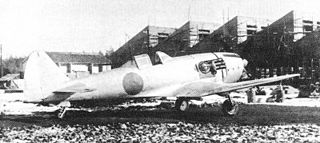
The Nakajima Ki-87 was a Japanese prototype high-altitude fighter-interceptor of World War II. It was a single seat, exhaust-driven turbo-supercharged engined, low-wing monoplane with a conventional undercarriage.
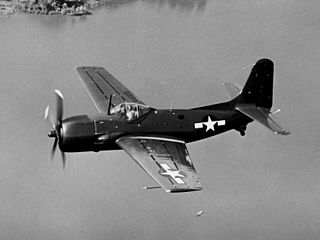
The Curtiss XBT2C was a prototype two-seat, single-engined dive/torpedo bomber developed during World War II for the United States Navy. Derived from the Curtiss SB2C Helldiver dive bomber, it was an unsuccessful competitor to meet a 1945 Navy specification for an aircraft to combine the roles that previously required separate types. Unlike the other competitors, the XBT2C was designed to accommodate a radar operator.

The Polikarpov TIS was a heavily armed Soviet heavy fighter designed during the early 1940s. Competing contemporaneous designs in the USSR included the Grushin Gr-1, Mikoyan-Gurevich DIS and Tairov Ta-3.
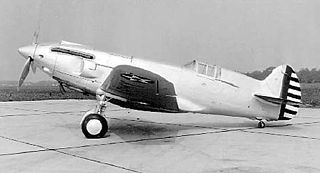
The Curtiss P-37 was an American fighter aircraft made by Curtiss-Wright in 1937 for the US Army Air Corps. A development of the Curtiss P-36 Hawk to use an inline engine instead of the radial engine of the P-36 the fuselage was lengthened and the cockpit moved back. A small number of YP-37 aircraft was built for Air Corps evaluation. The expected top speed was not achieved and the project terminated in favor of the Curtiss P-40.




















